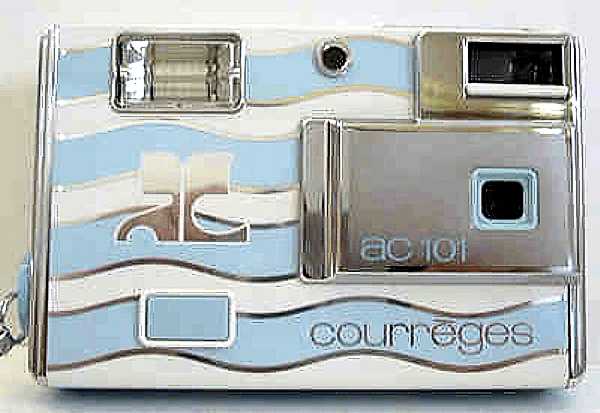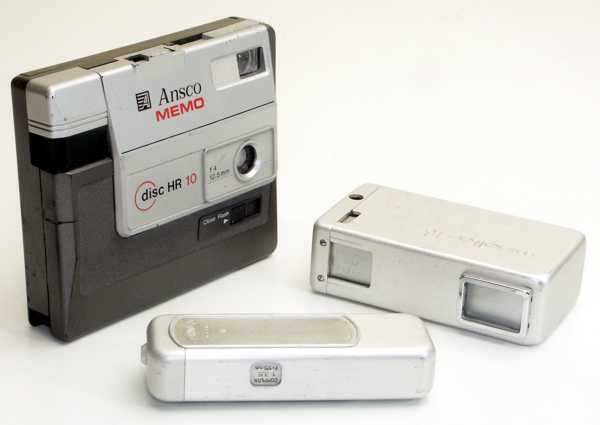
DISC CAMERAS

Too be clear, Kodak's original DISC cameras had high quality four-element lenses with an aspherical element, and a few other DISC camera manufacturers also produced great lenses, but most DISC cameras had simple three-element, plastic lenses. However, that wasn't enough to compensate for the camera-consumer connection. If not used carefully, these cameras -- even with good lenses -- will produce blurry results. The cameras are small and light, and while some have relatively fast shutter speeds -- thanks in part to the typically fast f2.8 lens (with a slower lens, a slower shutter speed is needed), they are very easily moved during the exposure. Add in the fact that the tiny negative requires extreme magnification to make a standard print, and you have a recipe for disaster. Forget about a decent 8x10" enlargement.
DISC cameras varied it their approach to correct exposure, and ranged from primitive, which relied a lot on the film's flexibility regarding exposure, to more "sophisticated", "auto-exposure" "systems" that typically had two shutter speed settings (such as 1/200 for SUNNY and 1/100 for CLOUDY/FLASH) and/or two f-stop settings (such as f6 for SUNNY and f2.8 for CLOUDY/FLASH).
Much like the Kodak 110 film format that preceded it, other camera makers jumped on the DISC camera bandwagon, sold DISC cameras with more features than the Kodak versions, at lower prices, and Kodak quickly dropped out. Haking was the leader of the pack, but most of Haking's cameras were sold under countless labels from Achiever to Zykkor. Kodak finally stopped selling the film in 1998 -- yet another disaster for Kodak -- and it helped push them into the shape they are in today.
In the end, the DISC camera is not in use today because the film discs could not be reloaded -- similar to the 110 fiasco that Kodak created earlier. But after the DISC camera failure, Kodak put its nose to the grindstone again, and decided to create yet another disaster -- the APS format, again with film cassettes which could not be reloaded. Three strikes and Kodak was OUT!!! Here's a shot of the smallest DISC camera (which had 15 exposures per disc) compared to a Minox camera having the same sized film format (center), and a Minolta 16mm camera with a format twice the size. The Minox and Minolta cameras used cassettes that are easy to reload providing over 24 exposures each, and have exposure controls of the film speed, shutter speed and aperture -- and are still being used today!

Many of these DISC camera, especially the inexpensive ones, were given away, or sold, for promotional purposes. That's how cheap many of them were! These promotional cameras are exactly the same as the cameras listed below, but have a decal or marking for the promoted product or company, and may appear in a different color than the original, for example. There are too many of these promotional cameras to list here, but you can find a list of many of them over at:
Surprisingly, despite being the largest film manufacturer in Europe at the time, Agfa did not get on the DISC camera bandwagon. I guess they figured, "These cameras use so little film, why bother?" Wise move.
see Dira Disc (below)
Also sold under the Voigtlander, Image, Osram, Wotan, and Starblitz labels.
A unique, rugged DISC camera with a big, rubberized handle for easy transport -- not that any DISC camera is difficult to "transport"! It is a bare-bones DISC camera -- it doesn't even have a flash, but it does accept a flip-flash bar. At first glance it looks like it might be a radio or have one built in, but it doesn't. No flash light or storage compartment either. Maybe it would have succeeded if it had! It was made by Halina which, not surprisingly, sold its own version to wannabe survivalists.
Stay tuned for more information
Stay tuned for more information
Stay tuned for more information
Same camera as the Dira Disc Alpha (above).
Stay tuned for more information
Stay tuned for more information
See Fujica
This Japanese corporation, best known for its Starblitz electronic flash units, sold a line of DISC cameras. Yes, they all had built-in flashes! They were not sold under the Fuji Koeki label, but under the Image, Osram, Starblitz, Wotan, Voightlander, and perhaps other, brand names instead -- see above and below.
see Dira Disc (above)
Stay tuned for more information
Stay tuned for more information
Also sold under the Voigtlander, Osram, Wotan, and Starblitz labels.
See Kodak 3100
Kinon is known for its "bargain basement" cameras, such as lightweight, plastic, "SLR"-look-a-like, viewfinder cameras that have a chunk of lead inside to fool you into thinking they have some "substance". The Discam 41 is a typical DISC camera with a built-in flash controlled by a CdS sensor, and a motor drive, but the lens and the shutter release are on a raised plate -- giving it a different style. Was there a Discam 40 or 42???????
See Keystone
Stay tuned for more information
Stay tuned for more information
This might just be some sort of confusion with MAXI DISC (below) -- but who knows? It might have existed, but in any case, it should not to be confused with MAXI DISC, MINI-DISC or MINIDISC (below) -- which turns out to be the same as the MAXI DISC 50, anyway. Confused?!?!?!? So are we. Want even MORE confusion? See below.
This should not be confused with the MINIDISC (below), but of course, it will be. It has NO built-in flash, plus the manufacturer is not marked on the camera, but it's a super-simple, re-badged Haking camera (see Ansco Memo Disc HR 10 -- and several others, as well). I guess they meant "MINI-features". 12.5mm f4 lens with two settings -- OFF & FLASH. Strictly a bare-bones camera. They do this just to confuse you.
Not to be confused with the MINI-DISC (above) -- but, of course, it will be. Built-in flash. The manufacturer is not marked on the camera, but it's the same as the Haking MAXI DISC 100 (see above) -- and undoubtedly others as well. 12.5mm f3.5 lens with three settings -- count 'em -- OFF, SUN & FLASH. They do this just to confuse you.
Stay tuned for more information
Stay tuned for more information
Stay tuned for more information
Stay tuned for more information
Undoubtedly just someone else's camera with a classy exterior, Darling.
Stay tuned for more information
Stay tuned for more information
Stay tuned for more information
It's another rebadged Haking with an f2.8 lens, built-in flash and motor drive. It was probably given away for free -- like a lot of DISC cameras -- as a promotional scheme after you bought enough Ron Rico Rum. Drink up!
Yet another rebadged Haking with an 12.5mm f2.8 lens, built-in flash and motor drive which need two AA batteries. It has an ON/OFF switch, and a sensor to decide about firing the flash. To top it on, it has a folding front cover.
The Fuji Koeki Co. in Japan is well-known for its Starblitz electronic flashes. They also made a line of DISC cameras that were sold under the Voigtlander, Osram, Wotan, and Image labels. So it's not surprising that they named one of these cameras the "Starblitz Flash Disc Macro".
Stay tuned for more information
Stay tuned for more information
It features a typical 12.5mm (f2.8) fixed focus lens, but with a full-face protective cover and wrist strap. Not bad for a bare-bones, give-away, subscription camera. They also offered a 35mm give-away camera as well.
A DISC camera that was so cheap is was given away, as a promotion from the Viceroy cigarette company. OK, it does have a built-in flash, and a slide-in lens cover, so it's not completely bare-bones, but the built-in, non-replaceable, battery was not designed to last much longer than a pack of cigarettes. It has the same ICON on the front plate as some Pettica DISC cameras (see above), so they share the same factory -- whose actual name will remain anonymous to protect the innocent.
Stay tuned for more information
Yes, there was a DISC camera sold with the Voightlander label, but it was not made by them. It was made by the Fuji Koeki Co. in Japan. It has a blue body, and was also sold as the Osram Flash Disc (see above) -- which only had a black body.
W. H. Smith is a chain of stationery stores in the U.K. This camera was either sold or given away to customers. It's undoubtedly a basic, re-badged Haking model. It has a built-in flash and film advance -- and needs two AA batteries to operate. It has the standard 12.5mm, fixed-focus, f2.8 lens, and the flash is controlled by a CdS sensor. A lever on the front covers up the lens -- or turns the camera ON.
One step above a bare-bones DISC camera because it has a motor drive -- so it needs a couple of AA batteries. In addition, it accepts a Flip-flash which is only fired if necessary, and is controlled by a sensor on the front. Probably sold under other labels, as well.

To return to the main index for the Sub Club click here.
COPYRIGHT @ 1995-2024 by Joe McGloin. All Rights Reserved.